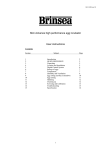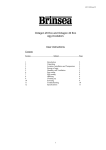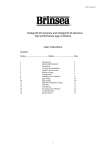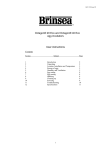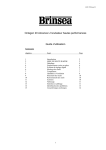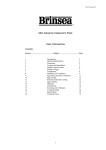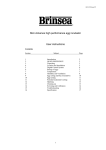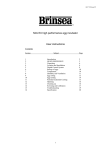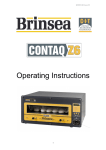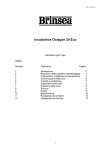Download Brinsea Octagon 20 Advance EX User's Manual
Transcript
AD21 GB Issue 01 Octagon 20 Advance high performance egg incubator User instructions Contents Section 1 2 3 4 5 6 7 8 9 10 11 12 13 14 15 Subject Introduction QUICK REFERENCE Unpacking Location and Installation Digital Control System Storage of eggs Temperature Humidity and Ventilation Egg setting Egg turning Hatching Cleaning up Servicing and Calibration Troubleshooting Specifications 1 Page 2 2 4 4 5 7 7 8 10 10 10 11 11 13 14 AD21 GB Issue 01 1 Introduction These instructions detail the operation of your new Octagon 20 Advance digital incubator and optional Autoturn Cradle. Please read these instructions carefully before setting up your machine to achieve best results and keep these instructions safe for future reference. This document includes recommended procedures for successful hatching but incubation involves the control and manipulation of a large number of factors and in certain circumstances different procedures may be necessary. Your incubator is designed to allow the user to vary the incubation conditions to suit a wide range of species in different ambient conditions and the specific set-up for every situation is beyond the scope of these instructions. There is a range of books available covering incubation techniques, for more information or to request a book list please don’t hesitate to contact us. The Octagon 20 Advance incubator is available with the option of the Advance Humidity Pump for automatic humidity control. Operating instructions for this module are supplied separately. Fig. 1 Functional features of the Octagon 20 Advance Digital Display Temperature Control Housing Cable Cover Control Buttons Adjustable Air Vent Turning Motor Housing Autoturn Cradle 2 Quick Reference (please read relevant section for detail) This quick reference is intended to allow users familiar with the Octagon 20 to quickly set up the incubator and learn the key features of the control system. Please read the rest of the instructions to obtain a full understanding of each feature. DO NOT COVER THE INCUBATOR. FOR INDOOR USE ONLY. 1) Carefully unpack the incubator (section 3) 2) Assemble the cradle (section 4) 3) Fit the power lead and cable cover – DO NOT OPERATE THE INCUBATOR WITHOUT THE CABLE COVER, ENSURE THE CABLE IS NOT CRUSHED OR PINCHED WHEN FITTING:- 2 AD21 GB Issue 01 MAIN MENU – QUICK REFERENCE PRESS BOTH BUTTONS TO UNLOCK THE MAIN MENU SELECT THE OPTION / RETURN TO THE MENU. GO FORWARD ONE SCREEN / INCREASE THE VALUE / DISPLAY IN CELSIUS. GO BACK ONE SCREEN / DECREASE THE VALUE / DISPLAY IN FAHRENHEIT. 37.5C OK - + INCUBATION TEMPERATURE. RANGE 20.0 – 40.0°C (68.0 – 104.0°F). DEFAULT 37.5°C (99.5°F). RH% OK Å Æ RH 20% EX ONLY RELATIVE HUMIDITY. RANGE 20% – 80%. DEFAULT 20%. ONLY FOR EX VERSION WITH ADVANCE HUMIDITY PUMP – SEE SECTION 8.7. ALARM HI OK Å Æ HI OK 2.0C - + HIGH TEMPERATURE ALARM. RANGE 1.0 – 5.0°C (1.8 – 9.0°F) ABOVE SET INCUBATION TEMPERATURE. DEFAULT 2.0°C (3.6°F). ALARM LO OK Å Æ LOW 3.0C OK - + LOW TEMPERATURE ALARM. RANGE 1.0 – 5.0°C (1.8 – 9.0°F) BELOW SET INCUBATION TEMPERATURE. DEFAULT 3.0°C (5.4°F). C/F OK Å Æ DISP C OK C F CELSIUS / FAHRENHEIT DISPLAY. SWITCHES ALL TEMPERATURE FIGURES BETWEEN °C AND °F. DEFAULT °C. TEMP OK Å Æ SAVE OK Å Æ SAVE. ALL CHANGES ARE SAVED. RETURN TO NORMAL OPERATION SCREEN. CANCEL OK Å Æ CANCEL. ALL CHANGES ARE IGNORED. RETURN TO NORMAL OPERATION SCREEN. 3 AD21 GB Issue 01 3 Unpacking Your incubator has been supplied in protective packaging. Please remove all tape, strapping and packing from the incubator and parts. Retain the carton and packing materials to enable the unit to be repacked. Your incubator will include as standard: Quantity Item 1 Incubator (including removable lid) 1 Egg tray 1 Cable cover and screw 1 Mains cable 1 Set of six egg dividers 1 Guarantee Card Optional Autoturn Cradle:2 1 1 1 Base bars Motorised cradle end Plain cradle end Set of four bolts 3.1 Please identify each part and check that they are all present and undamaged. If there are any parts damaged or missing please contact your retailer or Brinsea Products (at the address at the end of the document). 3.2 Note that if your incubator has been ordered with additional options (such as the Advance Humidity Pump) separate instructions and component lists apply. 3.3 Check also that the electrical supply matches the machine’s requirements (marked on the technical label on the inside of the lid of the incubator and on the inside of the blank Autoturn cradle end). 3.4 Complete and return your guarantee card to register for the free two year guarantee covering your incubator. 3.5 Go to www.Brinsea.co.uk and register as a free member of the Brinsea User Group (BUG) to receive the latest news and information such as advance notice about new products, special offers, exclusive competitions and much more. 4 Location and Installation 4.1 Your incubator will give best results in a room free from wide temperature variations and with generous ventilation – particularly if several incubators are running at the same time. Ensure that the room temperature cannot drop on a cold night. Ideally thermostatically control the room at between 20 and 25°C (68 and 77°F). Never allow the room temperature to drop below 15°C (59°F) and ensure that the incubator cannot be exposed to direct sunlight. 4.2 Connect the mains cable to the incubator lid. Ensure the connector is pushed fully home in its socket. 4.3 Fit the Cable Cover and tighten the screw. DO NOT OPERATE THE INCUBATOR WITHOUT THE CABLE COVER IN PLACE. ENSURE THE CABLE IS NOT CRUSHED OR PINCHED WHEN THE COVER IS FITTED. The cover is designed to prevent splashes of water reaching the electrical socket and it clamps the cable to prevent the connector coming loose. 4 AD21 GB Issue 01 4.4 If using the Autoturn cradle: Assemble the Autoturn cradle in accordance with the diagram below (Fig. 2) and place on a flat, level surface (workbench height is ideal). Place the incubator into the Autoturn cradle as illustrated (Fig. 1). The cabinet is designed to locate onto the lugs at either end of the Autoturn cradle. Take care to offer the incubator at the angle which matches that of the drive lug to avoid damage to the mechanism. Ensure full engagement in the slots in the ends of the incubator so that the incubator is level end to end. FIG. 2 4.5 If using without the Autoturn cradle place the incubator upright on a flat level surface. 4.6 Remove the lid, lift out the egg tray and fill one of the two water channels with water or 100:1 Brinsea Incubation Disinfectant Solution leaving the top of the liquid 3/4” (20mm) from the top of the channel. Replace the tray and replace the lid. Slide the ventilation control to the centre of its range. 4.7 Plug incubator and cradle mains supply cables into suitable outlets ensuring that the cables are not pulled tight. The incubator fan will start, the buzzer sound and the LCD display on the temperature control housing will display the air temperature and humidity. The cradle motor will start and the incubator will begin to turn. The turning is very slow – taking about half an hour to turn each way. 4.8 Allow the incubator to run for at least an hour to stabilise the temperature before making adjustments or setting eggs. 5 Digital Control System T*37.5C H*45% The Octagon 20 Advance control system utilises highly accurate, individually calibrated sensors for temperature and humidity. Be cautious of low cost analogue or digital thermometers and hygrometers when comparing them with the incubator display readings. 5 AD21 GB Issue 01 5.1 NORMAL OPERATION – Temperature and relative humidity are continuously displayed. The asterisk “*” adjacent to the temperature reading shows when the heater power is on. When warming the asterisk will be continuously on, once warmed up the asterisk will slowly flash as the heater is pulsed to maintain the correct temperature. When reducing the temperature setting the asterisk may go off, this is normal. The asterisk “*” adjacent to the relative humidity display is only on when the pump control output is on (see section 8) and is only applicable when using the optional Brinsea Advance Humidity Management Module. 5.2 POWER LOSS DISPLAY – If power has been interrupted due to a power cut (or when first switching on) a “P” is shown flashing in the corner of the display. Press OK for 2 or more seconds to clear the indicator. If the reason for the power loss is not known check the power cable connections are secure. Once the “P” indicator has been cleared, it is advisable to candle eggs a number of times to check for losses. T*37.5C H 45% P 5.3 HIGH TEMPERATURE ALARM DISPLAY – If the measured temperature goes up by more than the figure in the ALARM HI screen, the alarm will sound immediately and “+T” will be displayed. Press OK to silence the alarm for 30 minutes. If the high temperature problem rectifies itself the “+T” remains on the display to show this has happened. Press OK to clear the indicator. Check the incubator is not (and has not been) in direct sunlight or too near a heat source such as a room heater. It is advisable to candle eggs a number of times after this event to check for losses. T 39.8C H 45% +T 5.4 LOW TEMPERATURE ALARM DISPLAY – If the measured temperature goes down by more than the figure in the ALARM LO screen, after 30 minutes “-T” will be displayed and the alarm will sound. Press OK to silence the alarm for 30 minutes. If the low temperature problem rectifies itself the “-T” remains on the display to show this has happened. Press OK to clear the indicator. Check the incubator is not (and has not been) in a cold draught or that the room temperature has dropped significantly. It is advisable to candle eggs a number of times after this event to check for losses. T*32.1C H 45% -T 6 AD21 GB Issue 01 5.5 CHANGING SETTINGS – The Main Menu allows the various settings to be modified and saved. All changes are retained in the event of a power cut. To access the Main Menu press the + and – buttons simultaneously to unlock the display. For full details of menu settings please refer to the guide on page 3. 6 Storage of Eggs 6.1 Store eggs in cool, damp conditions. Most species may be safely stored for up to 14 days before serious reductions in hatch rates are likely. Daily turning of stored eggs also helps maintain hatchability. 6.2 Discard cracked, mis-shaped and heavily soiled eggs (if possible). Only wash soiled eggs using a brand egg wash solution such as Brinsea Incubation Disinfectant Concentrate following the manufacturer’s instructions. It is essential to wash eggs in solution which is significantly warmer than the egg. Bear in mind that all solutions will remove the outer cuticle from the egg as well as the dirt and may leave the egg at greater risk from bacterial contamination in the future. 7 Temperature Stable and correct temperature is essential for good results. Adjust with care. 7.1 Note: your incubator may not be set to the correct temperature from the factory and the following procedure must be followed before setting eggs. 7.2 As the incubator warms up and approaches its control setting the heater on asterisk “*” will change from continuously on to flashing. Allow the incubator to stabilise for at least an hour before adjusting the temperature. 7.3 Press the - and + buttons simultaneously to unlock the main menu. Press OK to select the temperature screen and adjust as necessary using the + and – buttons. Press OK to return to the Main Menu and then scroll down to Save. Press OK to save the changes. When reducing temperature the asterisk may go out while the incubator cools – this is normal. 7.4 Refer to the digital temperature display to check temperature. The display shows the air temperature in increments of 0.1°. Adjust temperature with care – small differences have large effects on hatching performance. 7.5 The Display can be switched to show all temperature settings in degrees Fahrenheit. Press the - and + buttons simultaneously to unlock the main menu. Scroll to the C/F option and press OK to select the C/F display screen. Press the + button to select °F or the – button to select °C. Press OK to return to the Main Menu and then scroll down to Save. Press OK to save the changes. 7.6 Recommended temperatures: Typical incubation period: Hens 37.4 – 37.6°C 99.3 – 99.6°F 21 days Pheasant 37.6 – 37.8°C 99.6 - 100°F 23-27 days Quail 37.6 – 37.8°C 99.6 - 100°F 16-23 days Ducks 37.4 – 37.6°C 99.3 – 99.6°F 28 days Geese 37.4 – 37.6°C 99.3 – 99.6°F 28-32 days Amazons 36.8 – 37.0°C 98.3 – 98.6ºF 24-29 days Macaws 36.8 – 37.0°C 98.3 – 98.6ºF 26-28 days Love birds 36.8 – 37.0°C 98.3 – 98.6ºF 22-24 days Parrots: 7 AD21 GB Issue 01 African Grey 36.8 – 37.0°C 98.3 – 98.6ºF 28 days Eclectus 36.8 – 37.0°C 98.3 – 98.6ºF 28 days 7.7 Developing embryos are fairly tolerant of short term temperature drops and the user need not be concerned about cooling that occurs when inspecting eggs. Temperatures above ideal can quickly have a serious detrimental effect on hatch rates and must be avoided. 7.8 The Octagon 20 Advance has a built-in temperature alarm which warns of high or low temperatures. See section 4 for details. 8 Humidity and Ventilation Short term variations in humidity are not important. The average humidity over the incubation period needs to be near optimum to achieve the ideal weight loss. High humidity for the day or two of hatching is also important. Beware chronic, excessive humidity. 8.1 Two factors affect incubation humidity: water evaporation within the cabinet (from eggs as well as from additional water) and levels of ventilation. The water content of the air being drawn through the incubator will also have an effect. 8.2 There are two methods available to bird breeders to achieve correct humidity levels in the octagon 20 Advance: A) Monitor humidity levels and adjust to match published guidelines for different species. Generally accepted incubation RH levels for species groups: During incubation Poultry Waterfowl Parrots 40-50% RH 45-55% RH 35-45% RH Hatching All species 65% RH or more For more specific information on particular species’ requirements check the relevant literature. B) Monitor egg weight loss which varies as a direct result of humidity and correct against published weight loss figures for the species. Eggs lose moisture through their shells and the rate of evaporation depends on the humidity levels around the eggs and the shell porosity. During incubation eggs need to lose a fixed amount of water which corresponds to a loss in weight of around 13-16% depending on species. By weighing eggs periodically during incubation it is possible to monitor and, if necessary, correct humidity levels to achieve the correct weight loss. Weigh the eggs on the day they are set in the incubator, take the average weight and plot this on a graph (see example below). The ideal weight loss line can be plotted by joining the point representing initial average weight with the ideal hatch weight (13-16% less depending on species) with the x-axis representing the incubation period (in days). By measuring actual average weights every few days the actual weight loss can be plotted and compared to the ideal weight loss line and corrections can be made. For example if the actual weight loss was greater than ideal (see graph below) then the air has been too dry and humidity levels need to be increased to compensate. Typical ideal weight losses for species groups: Poultry 13% 8 AD21 GB Issue 01 Parrots Waterfowl 16% 14% 9 AD21 GB Issue 01 68 66 64 62 60 58 56 54 Ideal weight (grams) 20 17 14 11 8 5 Measured weight (grams) 2 Average egg weight (grams) Egg weight loss chart Incubation period (days) 8.3 Of the two methods given above the most reliable is egg weight method and is recommended – particularly where poor hatch rates are experienced or if eggs of high value are being incubated. 8.4 Alter the setting of the ventilation control (reduce ventilation to increase humidity) and have water in neither, one or both of the water channels to change the humidity level. Humidity levels may be further increased by placing strips of evaporating card or cloth into one or both of the water troughs. Evaporating card is available from Brinsea Products. Folded evaporating card 8.5 In all cases the humidity for hatching needs to be high. Because of the short duration involved water/weight loss will not be significantly affected. High humidity is necessary to prevent membranes drying and hardening before the hatch fully emerges. Humidity will naturally increase as the first eggs begin to hatch and internal membranes begin to dry. This effect is in addition to the increased area of water evaporation from the water channels. 8.6 During hatching the high humidity levels will fall dramatically when the lid is opened and will take some time to build up. Resist the temptation to lift the lid frequently – leave for at least 6 hours between inspections. 8.7 The Brinsea Advance Humidity Pump is available as an option on the Octagon 20 Advance incubator. The incubator digital control system not only reads the humidity in the incubator but it provides a control signal to operate the water pump and accurately maintain the humidity level at the desired level. 10 AD21 GB Issue 01 9 Egg Setting 9.1 The Octagon 20 Advance is designed to be as flexible as possible, accommodating eggs of different sizes up to (and including) goose eggs and in different orientations. Some experimentation may be necessary to maximise capacity. 9.2 Before setting eggs ensure that the incubator has been run for several hours and has stabilised at the correct temperature. 9.3 Set the eggs in rows between the wire loop dividers. The dividers must be positioned such that the eggs rest on the tray bottom and are not pressured by the bar. The dividers prevent the eggs rolling. Eggs may be set on end (or at an angle) provided the large end of the egg is upwards. Eggs rolling through a few degrees between the dividers as the incubator turns are not in danger. 9.4 Once the eggs have been set the temperature must not be adjusted for 24 hours to allow the eggs to warm. Check the water level every 3 days or so and temperature daily. Candle the eggs after 1/3rd of the incubation period has elapsed to reject clear, infertile eggs (see section 12). 10 Egg Turning Warning: NEVER MANUALLY TURN THE INCUBATOR WHILE IT IS ON THE CRADLE, this will damage the turning mechanism and invalidate the guarantee. 11 AD21 GB Issue 01 10.1 The Autoturn cradle will continuously turn the incubator and eggs on an hourly cycle (through 90° and back) while plugged into the mains supply. Some small intermittent movement due to play in the gears is normal and does not cause harm. Lubrication of the plastic linkage with WD40 helps to ensure smooth, silent movement. 10.2 Ensure that nothing can impede the movement of the incubator on the cradle (such as a mains cable or having the incubator too close to a wall). 10.3 Altricial species such as parrots or birds of prey may benefit from additional manual turning through a full 180° once or twice a day. 11 Hatching 11.1 If hatching in the Octagon 20 Advance unplug the Autoturn cradle, remove the incubator from the cradle, place on the work surface in the upright position and remove the egg dividers two days before the hatch is due. 11.2 For maximum setting capacity, cleanliness, flexibility and performance a separate hatcher may be used. A second Brinsea Octagon 20, Octagon 10 or Hatchmaker incubators are recommended. Contact your dealer for details. 11.3 Eggs nearing hatch are slightly less sensitive to temperature variation and the hatching temperature can be reduced by up to 1°C (2°F) but this is not essential. 11.4 Hatching humidity levels need to be high (see section 7 above) but note that the ventilation control must be at least 1/3rd open during hatching. 11.5 When most eggs have hatched (12 to 48 hours) remove the hatchlings to a brooder. The Brinsea Cosylamp is ideal for poultry and waterfowl etc. The Brinsea TLC-4 Brooder is recommended for exotics. 11.6 During hatching the high humidity levels will fall dramatically when the lid is lifted and will take some time to build up. Resist the temptation to open the incubator frequently – leave for at least 6 hours between inspections. 12 Cleaning Up IMPORTANT: DISCONNECT THE INCUBATOR AND BASE FROM THE MAINS POWER SUPPLY DURING CLEANING. RISK OF ELECTRIC SHOCK! ENSURE THAT ALL ELECTRICAL PARTS ARE KEPT DRY. DO NOT IMMERSE THE YELLOW BASE. 12.1 NEVER WASH THE TRAYS, COVERS OR CABINET PARTS IN LIQUIDS OVER 50°C (120°F). DO NOT USE A DISHWASHER TO CLEAN TRAYS, INCUBATOR BASE OR LID. Following each hatch in the Octagon 20 Advance remove and wash the egg tray and dividers in Brinsea Incubation Disinfectant Solution. Wipe all other internal surfaces with a soft cloth soaked in the solution. Do not immerse the hollow yellow base as fluid may become trapped inside. Ensure that the instructions supplied with the fluid are followed. 12.2 Periodically unscrew the six screws retaining the fan cover, remove the cover and soak. Dust and fluff may be removed from the fan and heater cord with a soft brush. USE NO LIQUIDS. THE INCUBATOR MUST NOT BE USED WITHOUT THE FAN COVER FITTED. RISK OF ELECTRIC SHOCK! 12 AD21 GB Issue 01 WARM AIR DISTRIBUTION WILL BE ADVERSELY AFFECTED IF THE FAN COVER IS NOT IN PLACE. 12.3 If a separate hatcher is used the procedure above should still be followed every two months. 12.4 The exterior of the incubator and Autoturn cradle may be cleaned with a damp cloth. Avoid allowing any moisture to get inside mechanical housings. 12.5 Always clean the incubator before storage and ensure that the unit is totally dry inside and out. 13 Servicing and Calibration IMPORTANT: THE HEATER CORD AND CONNECTIONS ARE AT MAINS VOLTAGE. NEVER OPERATE THE INCUBATOR WITH THE FAN COVER REMOVED. RISK OF ELECTRIC SHOCK! 13.1 In case of failure first check that the mains power supply is working and that the mains cable connector is fully engaged in the socket beneath the cable cover. The digital control system may be reset to the original factory defaults by connecting the power supply while holding the OK button. Check temperature calibration after resetting to defaults. If the problem persists contact your distributor or Brinsea Products Service Dept. 13.2 The functional parts of the Octagon 20 Advance are modular and parts are available and are readily exchanged by a suitably qualified person equipped with basic tools. Fitting instructions are supplied with replacement parts. 13.3 The digital temperature and humidity display is individually calibrated during manufacture but may be recalibrated if required. To ensure optimal performance return the incubator to Brinsea Products Service dept. for re-calibration every two years. It is not recommended that this procedure is carried out by the user. BE CAUTIOUS OF LOW COST ANALOGUE OR DIGITAL THERMOMETERS AND HYGROMETERS. BRINSEA PRODUCTS LTD USES SOPHISTICATED INTERNATIONAL REFERENCE STANDARDS. EQUIPMENT TRACEABLE To access the Calibration Menu press all three buttons simultaneously to unlock the display. 13 TO AD21 GB Issue 01 CALIBRATION MENU PRESS ALL 3 BUTTONS TO UNLOCK THE CALIBRATION MENU SELECT THE OPTION / RETURN TO THE MENU. GO FORWARD ONE SCREEN / INCREASE THE VALUE. GO BACK ONE SCREEN / DECREASE THE VALUE. CAL TEMP OK Å Æ T 37.3C OK CAL! CALIBRATE THERMOMETER. TAKE READINGS AT SEVERAL PLACES 20mm ABOVE THE BASE OF THE EMPTY EGG BASKET AND CALCULATE THE AVERAGE. CAL RH% OK Å Æ RH 28% OK CAL! CALIBRATE HYGROMETER. PLACE HYGROMETER IN EGG BASKET WITH NO WATER IN TROUGHS. RH CYCLE OK Å Æ RHC 7S OK - + HUMIDITY PUMP CYCLE TIME. ONLY APPLICABLE WHEN USED WITH THE BRINSEA ADVANCE HUMIDITY PUMP. AMBIENT OK Å Æ T 20.0C OK - + AMBIENT TEMPERATURE COMPENSATION. AMBIENT TEMPERATURE USED IN HEATER CONTROL ALGORITHM. ONLY ADJUST IF DISPLAY VARIES BY MORE THAN +/- 0.2°C. 14 SAVE OK Å Æ CANCEL OK Å Æ 14 AD21 GB Issue 01 14 Troubleshooting 14.1 Poor hatching results are frustrating and can be caused by a large number of factors. The most common are given below. Brinsea Products will not be held responsible for loss of eggs or chicks under any circumstances. However we will try to advise on incubation technique to improve results where necessary. 14.2 Gather as much information from the hatching results as possible to enable the problem to be analysed in detail. Record dates that eggs are set, incubator settings, dates of hatches, weight losses and the number and condition of hatchlings. Candle or break open unhatched eggs to estimate the extent of embryo development. The Brinsea Cool-Lume or Egg-Lume candling lamps are available from your dealer. 1 2 1 10 20 3 7 4 5 6 1) Clear when candled - probably infertile (or very early death) when candled at 8 days 2) Fertile with red blood vessels - after 8 days 3) Red or black staining - early death when candled at 8 days 4) Embryo with red blood ‘ring’ - early death when candled at 8 days 5) Dark outline with ill defined detail - late death (10-16 days) 6) Live embryo with bill in air sack - due to hatch in 24-48 hours 7) Normal development of the air pocket according to number of days General guides: Observation No chicks hatch Likely Cause(s) Infertility, infection, drastically incorrect incubation settings, parent ill health. Chicks hatch earlier than expected, deformities. Chicks hatch later than expected Hatch dates widely spread Incubation temperature too high Late stage ‘death in shell’ Generally poor results Incubation temperature too low Different rates of development due to different storage times, incubation temperature variation. Incorrect humidity, probably too high. Incorrect incubation settings, poor parent bird health, inadequate egg turning, 15 Solution(s) Check egg viability – are similar eggs hatching naturally. Disinfect the incubator. Check incubator settings and procedures – particularly temperature. Reduce incubation temperature slightly 0.5°C (1°F) Raise incubation temperature slightly 0.5°C (1°F) Limit egg storage times. Check for incubation temperature variation – sunlight, large room variation etc. Try reducing average humidity levels (but see section 8 above) Improve parent bird health, check all incubation settings, analyse egg weight loss to confirm humidity correct, check turning working correctly. AD21 GB Issue 01 15 Specification OCTAGON 20 Advance Maximum Setting Capacities: Egg size Typical capacity Quail Pheasant Amazon/Macaw Hen Duck Goose 60 40 36 24 20 9-12 Dimensions: Incubator only Including Autoturn Cradle 35cm x 26cm x 26cm high 43cm x 26cm x 30cm high Weight: Incubator only Including Autoturn Cradle 2.70 Kg 3.25 Kg Power Consumption: Maximum (typical average) Autoturn cradle 45 Watts 25 Watts 4 Watts Electrical Supply: 230v 50Hz Brinsea Products Ltd, Station Road, Sandford, N. Somerset, BS25 5RA Tel: (01934) 823039 Fax: (01934) 820250 e-mail: [email protected], website: www.Brinsea.co.uk 16
















